Auditing - Classification of Reserves | 12th Auditing : Chapter 8 : Reserves and Provisions
Chapter: 12th Auditing : Chapter 8 : Reserves and Provisions
Classification of Reserves
Classification of Reserves
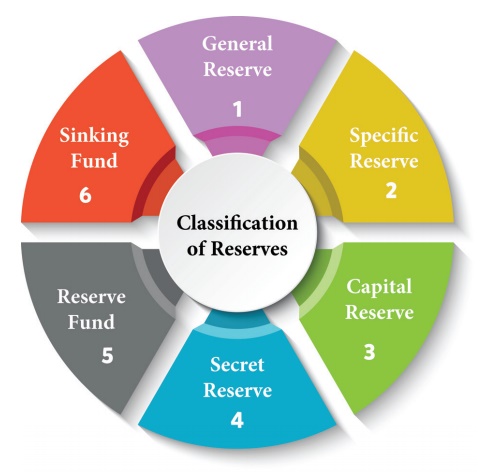
1. GENERAL RESERVE
A
reserve which is created out of the profits or surplus of a business for
meeting any unknown liability is called as ŌĆśGeneral ReserveŌĆÖ or ŌĆśFree ReserveŌĆÖ
or ŌĆśRevenue Reserve.ŌĆÖ It is an appropriation of profit. According to Companies
Act, creation of general reserve is not compulsory; it is to be created only
when the company has sufficient profit. However, if the Articles of Association
of the company state that a specific amount is to be set aside out of profit
before distribution of dividend, then the amount should be transferred to
General Reserve account.
Objects of creating General Reserve
It is
created with an object to:
┬Ę
Provide additional working capital,
┬Ę
Strengthen the liquid resources of the
business,
┬Ę
Meet any unknown contingency or liability,
┬Ę
Equalize dividend in the years in which profits
are inadequate, and
┬Ę
Expand business etc.

AUDITOR'S DUTY
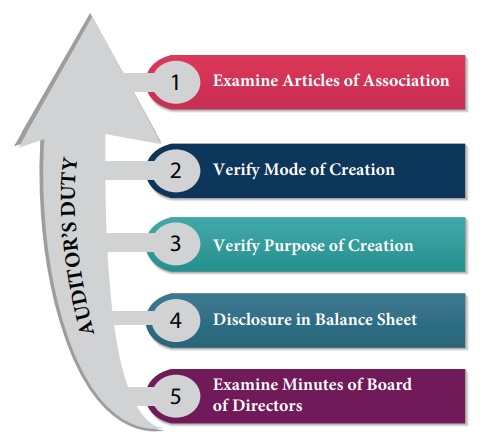
1. Examine Articles of Association: The auditor should examine the Articles of
Association to see whether provision regarding creation of general reserve has
been complied with.
2. Verify Mode of Creation: It is
the duty of the auditor to ensure
that reserve is created only out of profits of the company.
3. Verify Purpose of Creation: Auditor should ensure that general reserve is
created for the best interest of the company.
4. Disclosure in Balance Sheet: He
should examine that reserve amount
is properly shown in the Balance Sheet. When reserve amount is invested in
securities, he should verify that investments are shown on the assets side of
the Balance Sheet.
5. Examine Minutes of Board of Directors: Auditor
should examine Minutes of Board of Directors meeting to verify directors
approval for utilizing the reserve amount.
2. SPECIFIC RESERVE

A
reserve which is created for the purpose of providing for losses and
contingencies which are known or expected to occur at a future date is called
as a Specific Reserve. In simple words, it is a reserve created out of profit
or loss of a company for a specific purpose. For example, Dividend Equalization
Reserve, Investment Fluctuation Reserve, Reserve for redemption of Debentures,
Plant Replacement Reserve etc.
Specific
Reserve is not represented by any asset and therefore it is not available for
distribution amongst the shareholders. The reserve must be created irrespective
of profit or loss involved in the business.
Objects of creating Specific Reserve The
reserve is created with a definite object to:
┬Ę
Meet a known loss, such as depreciation, heavy
repairs and renewals etc.
┬Ę
Meet an expected contingency, such as, doubtful
debts, discount on debtors, liability for a disputed claim, contingency under
WorkmenŌĆÖs Compensation Act, etc.
┬Ę
Meet an outstanding liability for expenses
already incurred, such as, salaries and wages, commission, income tax and other
accrued expenses.
![]()
AUDITOR'S DUTY
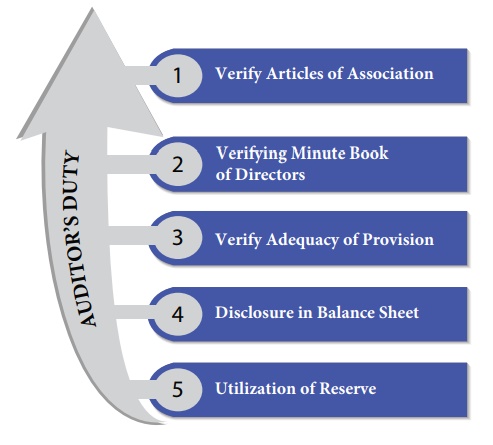
1.
Verify
Articles of Association: It is the duty of the auditor to verify the
Articles of Association to check whether the amount appropriated from profit to
specific reserve is duly complied.
2. Verifying Minute
Book of Board meeting: The auditor should ensure that profits are appropriated according to the board of directors
decision by verifying the Minutes book of the Board meeting.
3. Verify Adequacy of Provision: Auditor
should ensure that adequate provision has been created. In case if the amount
created is not adequate, he should insist the management to increase the
provision. Otherwise, he should disclose the same in the audit report.
4. Disclosure in
Balance Sheet: The auditor should see
whether provisions are properly shown on the liabilities side of the Balance
Sheet.
5. Utilization of Reserve: Lastly,
the auditor has to ensure that
reserve is utilized for the special purpose for which they are created.
3. CAPITAL RESERVE

A
reserve which is created out of capital profits of a company is called as a
Capital Reserve. It is defined in Part III of Schedule VI of the Companies Act
as, ŌĆ£any reserve which cannot legally be distributed amongst the shareholdersŌĆØ.
Capital profit refers to the following:
┬Ę
Profits on sale of fixed assets
┬Ę
Profits on revaluation of fixed assets and
liabilities
┬Ę
Profits earned prior to incorporation of a
company
┬Ę
Profits made in purchasing a business
┬Ę
Profits on redemption of debentures at a
discount
┬Ę
Premium received on issue of shares or
debentures
┬Ę
Profits earned from forfeited shares and
re-issue of forfeited shares
┬Ę
Exceptional profits not earned during regular
course of business.
Capital
profits should not be utilized in distributing dividend to the shareholders but
should be kept aside to strengthen the financial position of the
company and to meet capital or abnormal revenue losses.
Objects of creating Capital Reserve Capital
Reserve are utilised for the following purpose:
┬Ę
To issue bonus shares to the shareholders
subject to the Articles of Association of the company.
┬Ę
To write off intangible assets of the company,
like goodwill, preliminary expenses etc.
┬Ę
To provide for premium payable on the
redemption of debentures or redeemable preference shares.
┬Ę
To write off discount allowed, commission paid
or expenses incurred on the issue of shares and debentures of the company.
AUDITOR'S DUTY
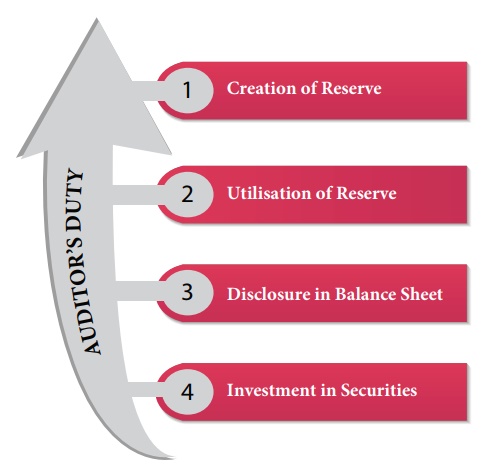
1. Creation of Reserve: The
auditor should ensure that the
reserve is created only out of the capital profits of the company.
2. Utilisation of Reserve: He
should verify that the reserve is
utilized according to the provisions of the Companies Act and the Articles of
Association of the company.
3. Disclosure in Balance Sheet: Auditor should examine whether capital reserve
has been shown separately from the revenue reserve in the Balance Sheet.
Any
addition or deduction from the previous year balance sheet should be clearly
shown.
4. Investment in Securities: The
auditor should check whether capital
reserve is invested in easily realizable securities or may be invested in the
business itself.
4. SECRET RESERVE

It is a
reserve, the existence of which is not apparent on the face of the Balance
Sheet. It is also called as ŌĆ£Hidden ReserveŌĆØ or ŌĆ£Internal ReserveŌĆØ or ŌĆ£Inner
ReserveŌĆØ. The reserve represents the surplus of assets over liabilities and
capital. Secret Reserves are usually created by banking companies, insurance
companies and electricity supply companies. When secret reserve exist, the
financial position of the company is better than what it would appear from the
balance sheet. However, the existence of such a reserve is found only by a
close and intelligent scrutiny of the account of the company.

Objects of creating Secret Reserve Secret
Reserve is created for the following purpose:
┬Ę
To meet any extraordinary loss without
disclosing the fact to the shareholders or outsiders.
┬Ę
To increase the working capital and to
strengthen the financial position of the company.
┬Ę
To withhold information of the progress of the
company from trade competitors.
┬Ę
To equalize the payment of dividend during the
period of loss.
┬Ę
To meet unexpected financial losses in future.
Methods of Creating Secret Reserve
┬Ę
Undervaluing the assets below cost or market
value.
┬Ę
Not recording the appreciated value of an
asset.
┬Ę
Providing excess reserve for bad and doubtful
debts or discount on debtors.
┬Ę
Providing excess depreciation on fixed assets.
┬Ę
Writing down goodwill to a nominal value
┬Ę
Omitting some of the assets in the Balance
Sheet.
┬Ę
Undervaluing the assets by charging capital
expenditure to revenue account.
┬Ę
Overvaluing the liabilities.
┬Ę
Inclusion of fictitious liabilities
┬Ę
Showing contingent liabilities as real
liabilities.
┬Ę
Grouping dissimilar items on the liabilities
side of the Balance Sheet.
AUDITOR'S DUTIES
1. Verify Articles of Association: The
auditor should study the Articles of
Association of the company to ascertain the legal implications of creating the
reserve.
2. Examine Object and Method of Creation: Auditor
should examine carefully the object and method of creating a secret reserve if
he is fully satisfied, he should disclose the facts in his report.
3. Disclosure to Shareholders: It is
the duty of the auditor to disclose
the fact to the shareholders that secret reserve has been created. If he fails
to do so, he will certify a false statement which will not exhibit a true and
fair view of the state of affairs of the company.
4. Examine CompanyŌĆÖs Policy: When secret reserve is created by
undervaluing the assets or overvaluing the liabilities, the auditor should make
a detailed enquiry with the directors and examine the companyŌĆÖs policy.
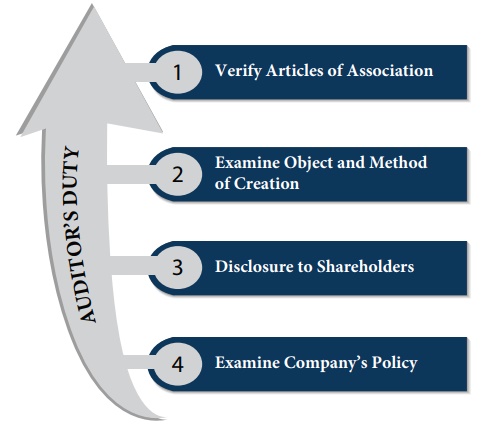
5. RESERVE FUND
It is a
reserve created out of the surplus of the company and is invested in outside
securities. It is similar to general reserve, which is created out of surplus
but is retained in the business. In other words, reserve fund is appropriations
of profits which is invested in safe securities and are easily realizable.
AUDITOR'S DUTY
1. Examine Directors meeting Minutes Book: Auditor
should examine the Minutes of Board
of Directors meeting to verify that all investments are made with the consent of the Board.
2. Verify Investment Register: The auditor should physically verify the
securities with the Investment Register.
3. Investment in Securities: The
auditor should ensure that the
reserve fund is invested in easily realizable securities.
4. Disclosure in Balance Sheet: He should verify that the reserve fund is
shown distinctly on the liabilities side of the Balance Sheet.
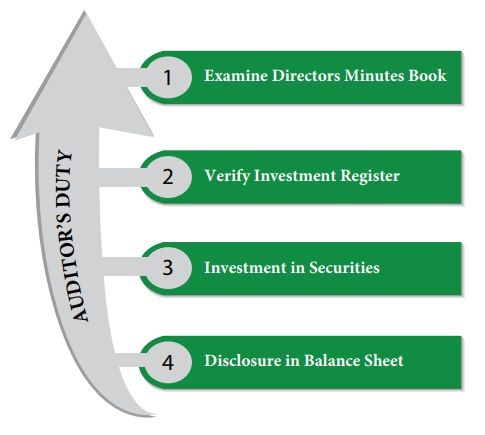
6. SINKING FUND
The fund
which is created to have a certain sum of money accumulated for a future date
by setting aside a certain sum of money every year is called as Sinking Fund.
It is defined as, ŌĆ£a form of specific reserve set aside for redemption of a
long debt or replacement of a wasting or a depreciable assetŌĆØ.

Objects of Creating Sinking Fund
The
objects of creating Sinking Fund are as follows:
┬Ę
To reduce a liability, for example, redemption of
debentures or repayment of a loan.
┬Ę
To replace a wasting asset.
┬Ę
To replace a depreciating asset.
┬Ę
To renew a lease.

AUDITOR'S DUTY
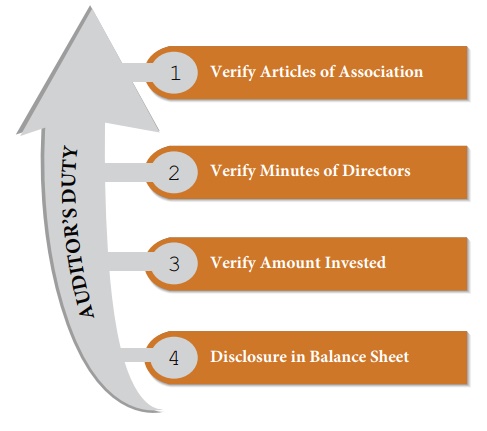
1. Verify Articles of Association: Auditor should verify Articles of Association
and examine the creation and utilisation of the fund.
2. Verify Minutes of Directors: He
should verify the Minutes of the
Board of Directors to ensure the correctness of the amount transferred to
Sinking Fund.
3. Verify amount Invested: He
should ensure that the amount set
aside is invested in guilt-edged securities known as Sinking Fund Investment
which earns a reasonable rate of return.
4. Disclosure in Balance Sheet: The auditor should verify that sinking
fund and Sinking Fund Investment is separately and properly disclosed in the
Balance Sheet.
Related Topics